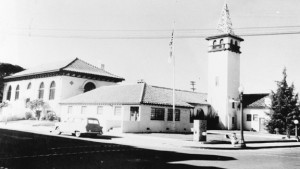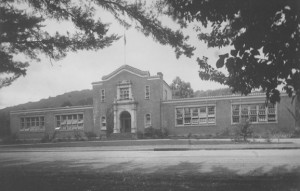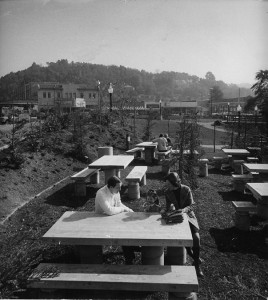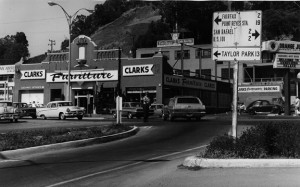
Town Hall with administrative wing
Changes to San Anselmo during these busy decades included the relocation and expansion of the Post Office in 1947, the addition of a Town Hall administrative wing in 1955, and the expansion of the Library in 1960. Downtown got new street lights in the early ’60s, a second fire station opened in 1963, and Red Hill Shopping Center opened in 1967.

Main School was renamed Wade Thomas School in 1946
New schools were built, including Lower Brookside (1946), Sleepy Hollow (1952), Hidden Valley (1957), and Red Hill Middle School (1967). In 1946, Main School was rebuilt and renamed Wade Thomas in honor of the long-serving school district superintendent and principal. Sir Francis Drake High School opened in 1951 on farmland formerly owned by the Cordone family. In 1965, San Domenico School moved from San Rafael to Sleepy Hollow.
More new homes went up along Butterfield Road and in the surrounding neighborhoods. Residents of Sleepy Hollow founded their Homes Association in 1946, the clubhouse was built in 1950, and the pool was completed in 1954. New parkland was being added as well: In 1965, San Anselmo acquired the 62-acre Sorich Ranch. Creek Park, with its mix of parking and lawns, was completed in 1970. Four years later, Frederick Faude donated 13.5 acres of panoramic ridge land.

Newly constructed Creek Park
By the 1960s, it was evident that something had to be done about the roads. In this regard, the town was responding to what was happening around it, not necessarily in it. The town’s population had already peaked at around 12,000, where it remains today.
Elsewhere in Marin, the population was growing at record numbers: Between 1950 and 1970, 123,300 new residents were added to the county’s census rolls. The impact of this growth was felt in San Anselmo at the Hub and on the streets that fed into it. Traffic had become the pressing issue.
The trains were already history, and by 1963, the Greyhound buses that replaced the railroad were gone, the railroad property condemned, the Depot razed-and the Town was in the beginning stages of a 10-year street renovation that would restructure Sir Francis Drake, Center Boulevard, and the Hub itself. It did so in large part to block by its own initiative what the County was recommending: Building a freeway through the Ross Valley to connect with Highway 101.

Hub Intersection, 1969
When the project began in 1961, Drake was a two-lane road, Center did not extend through to the Hub, and the Hub itself was what a Town engineer called a “free-for-all” as cars maneuvered through the intersection without benefit of traffic lights. Stops signs controlled left-hand turns from Drake onto the Miracle Mile and on Miracle Mile into Drake. In 1970, when the work was completed, the Hub was as we know it today, with one major difference: 30 years ago 32,600 vehicles passed through the intersection. As of 2004, the number was 65,000.

